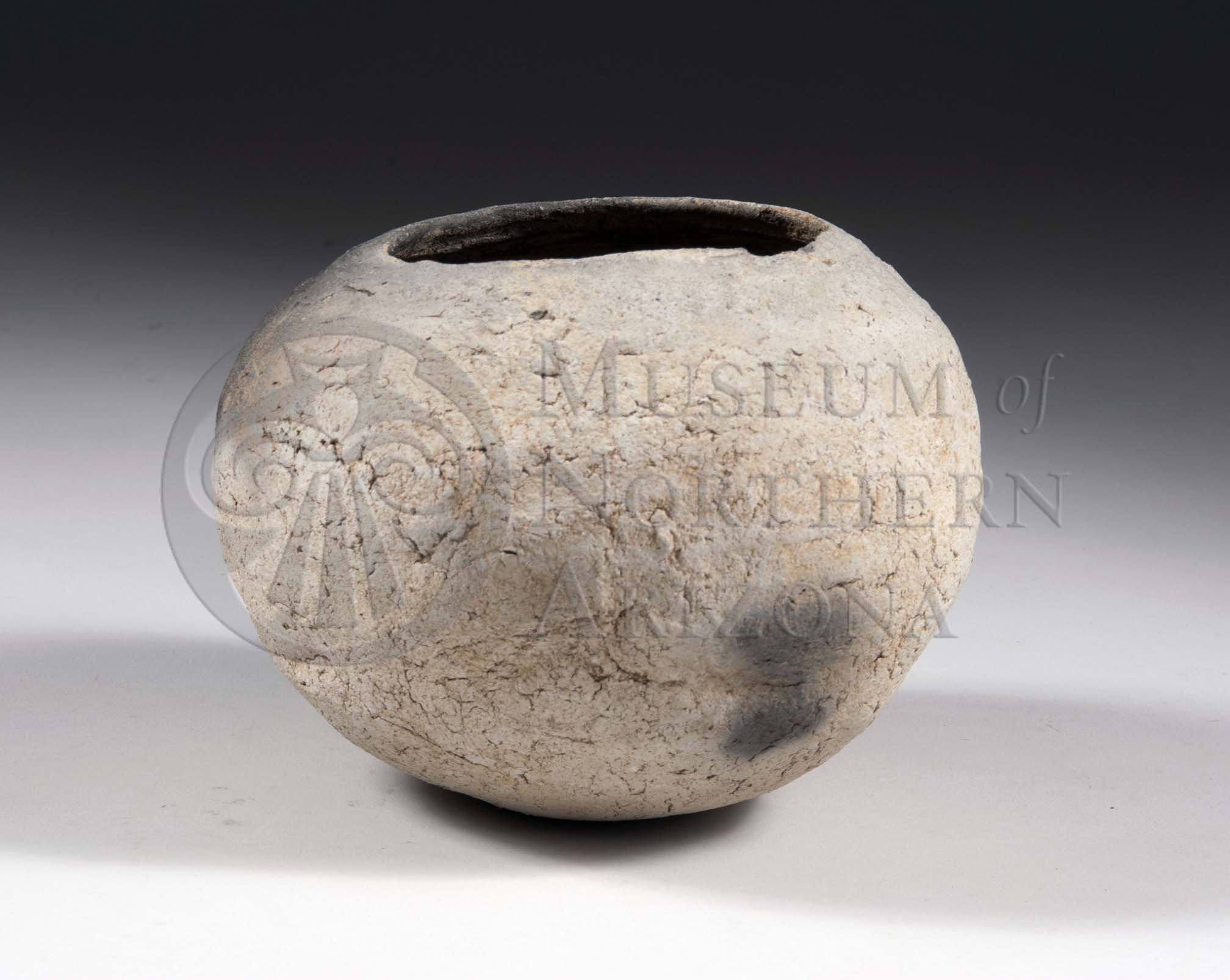
Lino Gray seed bowl from the Museum of Northern Arizona collections. Click the image to open the Lino Gray gallery.
Lino Gray is the earliest type of Tusayan Gray Ware and has a distribution covering southwestern Colorado, northwestern New Mexico, northern Arizona north of the Mogollon Rim, and southern Utah west to Havasupai Canyon. This type is also found in the Virgin Valley, Utah, but most likely arrived there through trade.
Archaeological Culture: Ancestral Puebloan, Kayenta
Date Range: Kayenta Heartland: A.D. 600-900 (Christenson 1994), Flagstaff Area: A.D. 550-825 (per Christian Downum, Northern Arizona University).
Construction: By coiling.
Firing: In a reducing atmosphere.
Core Color: Usually dark gray or almost black, sometimes light gray.
Temper: Abundant medium-fine to coarse quartz sand; temper conspicuous on the vessel surface.
Surface Finish: Very roughly finished; scraped and occasionally lightly smoothed in spots; never slipped; usually deeply pitted; scraping marks very conspicuous. Lino Fugitive Red variant jar exteriors and bowl interiors coated with a thin red wash that almost completely weathers away or rubs off easily on unweathered specimens.
Surface Color: Normally gray. Lino Fugitive Red variant may have a faint reddish or pinkish wash.
Forms: Bowls, jars (predominant), pitchers, dippers, canteens (rare); often difficult to distinguish jar sherds from bowl sherds; vessel walls generally of fairly uniform thickness in individual vessels, but wide in variation between vessels.
Vessel Thickness: 2.5 to 9.7 mm; greatest individual range recorded 3.5 mm; average thickness 4.9 mm.
Decoration: No painted decoration. The wash on the Lino Fugitive Red variant is red ochre (hematite).
Comparisons: Kana’a Gray has unobliterated wide and flattened neck coils; body sherds are scraped and generally indistinguishable. Coconino Gray has unobliterated neck coils emphasized with horizontal tooling; body and base sherds are scraped and indistinguishable. Medicine Gray has unobliterated neck coils that are relatively narrow and usually slightly finger-indented; base and body sherds are scraped and indistinguishable. Honani Tooled and O’Leary Tooled are decorated on the necks with tooling; base and body sherds are indistinguishable. Kiet Siel Gray frequently has coarser sand temper with small amounts of opaque angular fragments, coils often not quite obliterated, thicker vessel walls, bumpy less well-smoothed surfaces, and fillet rims, generally. Deadmans Gray is constructed by paddling, have micaceouse particles in the temper, fine core texture, and well-smoothed surfaces lacking scoring and pitting.
Other Names : Blackware, Post-Basketmaker Pottery, Post-Basketmaker Ware, Plain Gray Ware, Lino Gray Ware.
Variants: Lino Fugitive Red – same as Lino Gray, except for thin red wash on bowl interiors and jar exteriors. Lino Fugitive Red may represent an early attempt to produce a pottery vessel the same color as vessels fired in an oxidizing atmosphere. The only way this red color could be produced on vessels fired in a reducing atmosphere would be by painting the vessel after it was fired, as the paint would turn gray if fired.
Compiled from the following sources:
Christenson, Andrew (1994) A Test of Mean Ceramic Dating Using Well-Dated Kayenta-Anasazi Sites. Kiva 59(3):297-317.
Colton, Harold S. (1953) Potsherds. Museum of Northern Arizona Bulletin 25. Museum of Northern Arizona, Flagstaff.
Colton, Harold S., and Lyndon L. Hargrave. (1937) Handbook of Northern Arizona Pottery Wares. Museum of Northern Arizona Bulletin 11, Flagstaff, Arizona.
Compiled by:
April Peters, Northern Arizona University Anthropology Laboratories.
